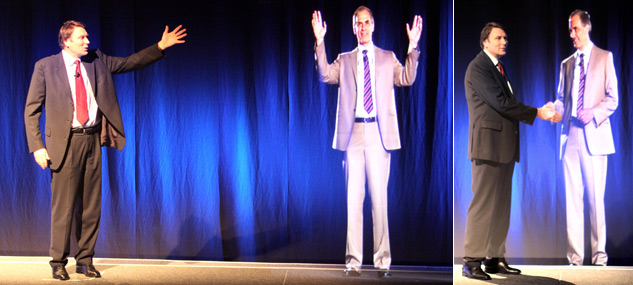And how about teleprompter Presidents?
– Holograms could soon replace airport workers (IO9, Aug 10, 2012)
The man who trades freedom for security does not deserve nor will he ever receive either. – Benjamin Franklin
And how about teleprompter Presidents?
– Holograms could soon replace airport workers (IO9, Aug 10, 2012)
‘Panem et circenses’ (‘Bread and circuses‘) desperately needs a few updates, because the people are starting to wake up.

A hologram of Princess Leia appears in the film Star Wars.
THREE-DIMENSIONAL television may be the latest in home cinema, but it will soon seem so 2010. Scientists are already planning its successor — holographic television.
On a holo-TV, images will be projected into the middle of a room as a “cloud” that can be enjoyed from every angle without 3-D glasses.
It may even be possible to broadcast concerts in other arenas around the world and to view live, lifesize sporting events in stadiums thousands of miles from the real players.
Holographic enthusiasts have named it the “Stars Wars technology”, after a scene in the 1977 blockbuster where a holographic image of Princess Leia is briefly projected from the robot R2-D2 pleading: “Help me, Obi-Wan Kenobi.”
NHK, the Japanese equivalent of the BBC, has committed to creating the first holo-TV within six years.
It is sponsoring research at giant Japanese companies such as Sony and Mitsubishi and has dispatched engineers to America, where scientists have already generated basic holographic transmissions. It sounds like it won’t be long before holographic images can be projected into our living rooms as we are relaxing by playing cheeky bingo. This research is likely to revolutionise the way we view images and communicate with each other.
The University of Arizona recently announced it had used lasers and powerful computers to generate single-coloured clouds of images. Nasser Peyghambarian, professor of optical sciences at the university, said adding colour and fluid movement was “closer than ever”.
NHK has earmarked £2.8 billion for developing holo-TVs, as part of Japan’s bid to host the 2022 World Cup in Tokyo, but hopes to have prototypes working much earlier.
TOKYO (Reuters Life!) – Imagine a light switch or a book that appears only when you need it — Japanese scientists are one step closer to making the stuff of sci-fi films into reality after creating a hologram that can also be felt.
“Up until now, holography has been for the eyes only, and if you’d try to touch it, your hand would go right through,” Hiroyuki Shinoda, professor at Tokyo university and one of the developers of the technology, told Reuters.
“But now we have a technology that also adds the sensation of touch to holograms.”
Holograms — three-dimensional images — are commonly found on credit cards, DVDs and CDs to prevent forgery, and larger scale holograms have been used in entertainment.
By using ultrasonic waves, the scientists have developed software that creates pressure when a user’s hand “touches” a hologram that is projected.

Telecommuting … Dr Hugh Bradlow appearing in Adelaide as a live hologram, and right, shaking hands with an executive / AAP
In an Australian first, Dr Bradlow’s life-sized, real-time hologram walked, talked and interacted with business executives at an Adelaide conference while he stood in front of cameras in Telstra’s Melbourne office.
Cameras and microphones in Adelaide allowed Dr Bradlow to see and hear his subjects from 725kms away as his audience watched his high definition image projected onto a transparent screen or “foil”.
The technology created by British company Musion Eyeliner has already enabled former US vice president Al Gore to speak to the Live Earth concert’s London audience from Tokyo and retailer Target to host a model-less virtual fashion show in New York last year.
UK band Gorillaz has also used Musion to give life to three-dimensional cartoon characters who performed their song at a 2005 MTV Awards concert in Portugal as rappers interacted with them live on stage.
But it’s not just for entertainment value, said Telstra enterprise and government group managing director David Thodey who shook “airhands” with Dr Bradlow during the function.
There are real applications for this “gee whiz” technology, he said.
He said companies wanting to reduce carbon emissions could replace business flights with live broadcasts.